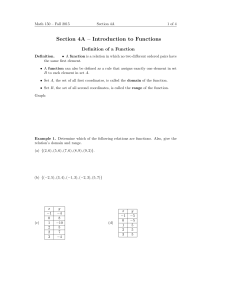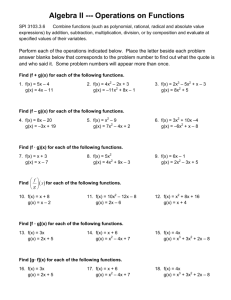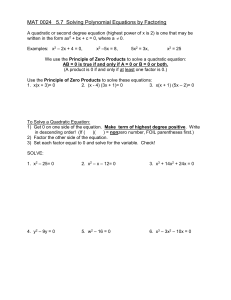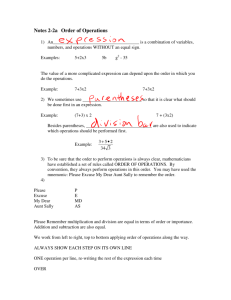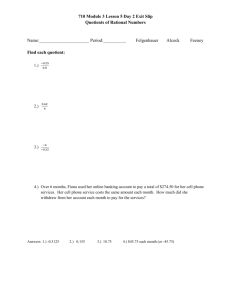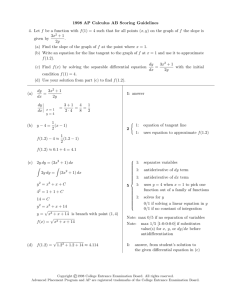UNIT I: FOUNDATIONS FOR FUNCTIONS Expanded Function
advertisement
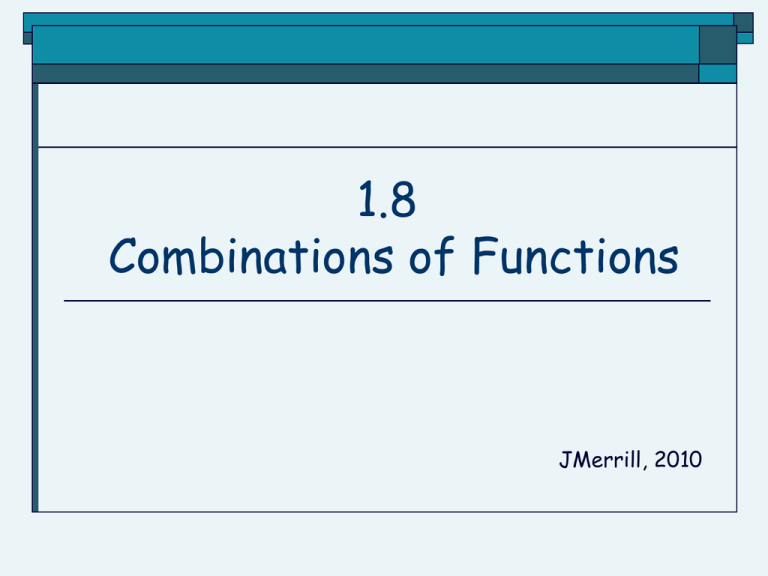
1.8 Combinations of Functions JMerrill, 2010 Arithmetic Combinations ( f g )( x) f ( x) g ( x) Sum Let f ( x) 5x 2 x 3 2 g ( x) 4 x 7 x 5 2 Find (f + g)(x) (5 x 2 x 3) (4 x 7 x 5) 2 9 x 5x 2 2 2 Difference Let ( f g )( x) f ( x) g ( x) f ( x) 5 x 2 2 x 3 g ( x) 4 x 2 7 x 5 Find (f - g)(x) (5 x 2 x 3) (4 x 7 x 5) 2 x 9x 8 2 2 ( fg )( x) f ( x) g ( x) Product Let f ( x) 5 x Find ( fg )( x) g ( x) 3 x 1 2 5 x (3x 1) 2 15 x 5 x 3 2 f f ( x) where g ( x) 0 ( x) g ( x) g Quotient Let Find f ( x) 5 x f ( x) g 5x 3x 1 2 2 g ( x) 3 x 1 You Do: Let f ( x) x 3, g ( x) x 9 2 Find: (f+g)(x) x x 12 2 (f-g)(x) (f•g)(x) x 3x 9 x 27 3 x x 6 2 (g-f)(x) x x6 2 2 f ( x) g 1 x3 Finding the Domain of Quotients of Functions To find the domain of the quotient, first you must find the domain of each function. The domain of the quotient is the overlap of the domains. Example Given f(x) x and g(x) 4 x2 f g Find the domains of (x) and (x) f g The domain of f(x) = [0, ) The domain of g(x) = [-2,2] Example f f(x) x x g(x) 4 x2 g g(x) g (x) f(x) f 4 x2 x Since the domains are: f(x) = [0, ) g(x) = [-2,2] The domains of the quotients are f : [0,2) g g : (0,2] f Composition of Functions Most situations are not modeled by simple linear equations. Some are based on a system of functions, others are based on a composition of functions. A composition of functions is when the output of one function depends on the input from another function. Compositions Con’t For example, the amount you pay on your income tax depends on the amount of adjusted gross income (on your Form 1040), which, in turn, depends on your annual earnings. Composition Example In chemistry, the process to convert Fahrenheit temperatures to Kelvin units 5 c(t ) ( f 32) 9 k (c) c 273 This formula gives the Celsius temp. that corresponds to the Fahrenheit temp. This formula converts the Celsius temp. to Kelvins This 2-step process that uses the output of the first function as the input of the second function. Composition Notation (f o g)(x) means f(g(x)) (g o f)(x) means g(f(x) Composition of Functions: A Graphing Approach (f g)(x) and (g Find ( f g )( 1) f ( g (1)) f (3) f (3) 0 Find ( g f )(3) g ( f (3)) g (0) g (0) 2 f)(x) You Do f(g(0)) = 4 g(f(0)) = 4 f(x) g(x) (f°g)(3) = 3 (f°g)(-3) = 3 (g°f)(4) = 0 (f°g)(4) = 0 Compositions: Algebraically Given f(x) = 3x2 and g(x) = 5x+1 Find f(g(2)) Find g(f(4)) How much is f(4)? g(2)=5(2)+1 = 11 f(11) = 3(11)2 g(48) = 5(48)+1=241 =363 Compositions: Algebraically Con’t Given f(x) = 3x2 and g(x) = 5x+1 Find f(g(x)) Find g(f(x)) What does f(x)=? What does g(x)=? f(5x+1) g(3x2) = 5(3x2)+1=15x2+1 =3(5x+1)2 =3(25x2+10x+1) =75x2+30x+3 You Do f(x)=4x2-1 Find: (f g)(x) g(x) = 3x (g f)(x) f(g(x)) g(f(x)) f(3x) g(4x2 1) 4(3x)2 1 4(9x ) 1 2 36x2 1 3(4x 1) 2 12x2 3

